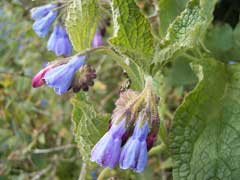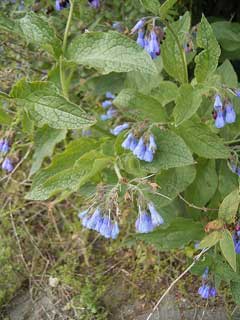 |
|
http://commons.wikimedia.org/wiki/User:TeunSpaans |
 |
| http://commons.wikimedia.org/wiki/User:TeunSpaans |
Translate this page:
Summary
Physical Characteristics

 Symphytum asperum is a PERENNIAL growing to 1.5 m (5ft) by 0.6 m (2ft in) at a fast rate.
Symphytum asperum is a PERENNIAL growing to 1.5 m (5ft) by 0.6 m (2ft in) at a fast rate.
See above for USDA hardiness. It is hardy to UK zone 5. It is in flower from May to June, and the seeds ripen from June to July. The species is hermaphrodite (has both male and female organs) and is pollinated by Bees.
Suitable for: light (sandy), medium (loamy) and heavy (clay) soils and can grow in heavy clay soil. Suitable pH: mildly acid, neutral and basic (mildly alkaline) soils. It can grow in semi-shade (light woodland) or no shade. It prefers moist soil.
UK Hardiness Map
US Hardiness Map
Synonyms
Plant Habitats
Woodland Garden Sunny Edge; Dappled Shade; Shady Edge; Cultivated Beds;
Edible Uses
Edible Parts: Leaves Shoots
Edible Uses: Gum Tea
The following reports are for S. officinale, they are said to also apply to this species[200]. Young leaves - cooked or raw[2, 4, 5, 9, 46, 61]. The leaf is hairy and the texture is mucilaginous. It may be full of minerals but it is not pleasant eating for most tastes. It can be chopped up finely and added to salads, in this way the hairiness is not so obvious[183]. Young shoots can be used as an asparagus substitute[46]. The blanched stalks are used[183]. Older leaves can be dried and used as a tea[26]. The peeled roots are cut up and added to soups[183]. A tea is made from the dried leaves and roots[183]. The roasted roots are used with dandelion and chicory roots for making coffee[183].
References More on Edible Uses
Medicinal Uses
Plants For A Future can not take any responsibility for any adverse effects from the use of plants. Always seek advice from a professional before using a plant medicinally.
Anodyne Astringent Demulcent Emollient Expectorant Haemostatic Refrigerant Vulnerary
The leaves are anodyne, mildly astringent, demulcent, emollient, expectorant, haemostatic, refrigerant and vulnerary. They are used as an external poultice in the treatment of cuts, bruises and sprains. Internally, they are used as a tea in the treatment of chest complaints. The plant contains a substance called 'allantoin', a cell proliferant that speeds up the healing process[4, 21, 26, 165]. The leaves are harvested in the summer and can be used fresh or dried.
References More on Medicinal Uses
The Bookshop: Edible Plant Books
Our Latest books on Perennial Plants For Food Forests and Permaculture Gardens in paperback or digital formats.

Edible Tropical Plants
Food Forest Plants for Hotter Conditions: 250+ Plants For Tropical Food Forests & Permaculture Gardens.
More

Edible Temperate Plants
Plants for Your Food Forest: 500 Plants for Temperate Food Forests & Permaculture Gardens.
More

More Books
PFAF have eight books available in paperback and digital formats. Browse the shop for more information.
Shop Now
Other Uses
Biomass Compost Gum
The following reports are for S. officinale, they are said to also apply to this species[200]. The plant grows very quickly, producing a lot of bulk. It is tolerant of being cut several times a year and can be used to provide 'instant compost' for crops such as potatoes. Simply layer the wilted leaves at the bottom of the potato trench or apply them as a mulch in no-dig gardens. A liquid feed can be obtained by soaking the leaves in a small amount of water for a week, excellent for potassium demanding crops such as tomatoes. The leaves are also a very valuable addition to the compost heap[26, 200]. A gum obtained from the roots was at one time used in the treatment of wool before it was spun[100].
Special Uses
References More on Other Uses
Cultivation details
Tolerates most soils and situations but prefers a moist soil and some shade[1, 4]. Grows well in heavy clay soils. Best grown in an open sunny site in a deep rich soil if it is being grown for compost material[200]. Plants can be invasive, often spreading freely by means of self-sown seed. They are also very difficult to remove, the root system is very deep and even small fragments of root left in the soil can produce new plants.
References Carbon Farming Information and Carbon Sequestration Information
Temperature Converter
Type a value in the Celsius field to convert the value to Fahrenheit:
Fahrenheit:
The PFAF Bookshop
Plants For A Future have a number of books available in paperback and digital form. Book titles include Edible Plants, Edible Perennials, Edible Trees,Edible Shrubs, Woodland Gardening, and Temperate Food Forest Plants. Our new book is Food Forest Plants For Hotter Conditions (Tropical and Sub-Tropical).
Shop Now
Plant Propagation
Seed - sow spring or autumn in a cold frame. When they are large enough to handle, prick the seedlings out into individual pots and grow them on in the greenhouse for their first winter. Plant them out into their permanent positions in late spring or early summer, after the last expected frosts. If you have sufficient seed you can try an outdoor sowing in situ in the spring. Division succeeds at almost any time of the year. Simply use a spade to chop off the top 7cm of root just below the soil level. The original root will regrow and you will have a number of root tops, each of which will make a new plant. These can either be potted up or planted out straight into their permanent positions.
Other Names
If available other names are mentioned here
Native Range
TEMPERATE ASIA: Iran (north), Turkey (northeast), Russian Federation-Ciscaucasia (Ciscaucasia), Armenia, Azerbaijan, Georgia, Russian Federation (Dagestan)
Weed Potential
Right plant wrong place. We are currently updating this section.
Please note that a plant may be invasive in one area but may not in your area so it's worth checking.
Conservation Status
IUCN Red List of Threatened Plants Status :

Growth: S = slow M = medium F = fast. Soil: L = light (sandy) M = medium H = heavy (clay). pH: A = acid N = neutral B = basic (alkaline). Shade: F = full shade S = semi-shade N = no shade. Moisture: D = dry M = Moist We = wet Wa = water.
Now available:
Food Forest Plants for Mediterranean Conditions
350+ Perennial Plants For Mediterranean and Drier Food Forests and Permaculture Gardens.
[Paperback and eBook]
This is the third in Plants For A Future's series of plant guides for food forests tailored to
specific climate zones. Following volumes on temperate and tropical ecosystems, this book focuses
on species suited to Mediterranean conditions—regions with hot, dry summers and cool, wet winters,
often facing the added challenge of climate change.
Read More
Expert comment
Author
Lepech.
Botanical References
17200
Links / References
For a list of references used on this page please go here
Readers comment
| Add a comment |
|
If you have important information about this plant that may help other users please add a comment or link below. Only comments or links that are felt to be directly relevant to a plant will be included. If you think a comment/link or information contained on this page is inaccurate or misleading we would welcome your feedback at [email protected]. If you have questions about a plant please use the Forum on this website as we do not have the resources to answer questions ourselves.
* Please note: the comments by website users are not necessarily those held by PFAF and may give misleading or inaccurate information.
To leave a comment please Register or login here All comments need to be approved so will not appear immediately.
|
Subject : Symphytum asperum
|
|
|
|